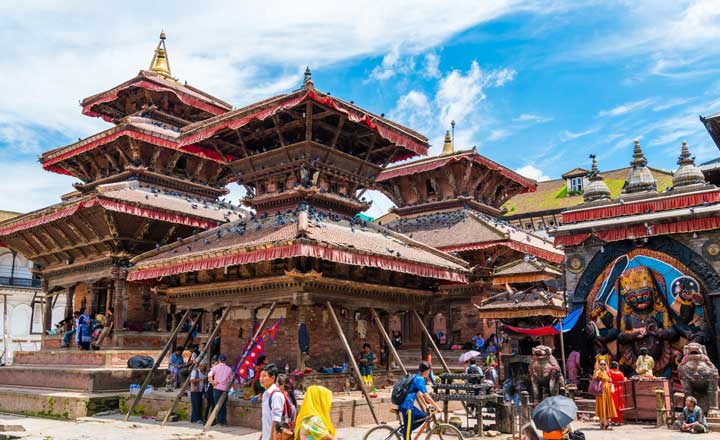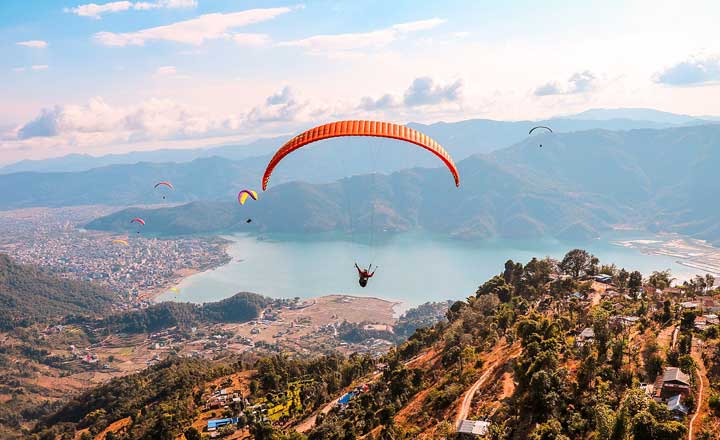

Overview
...
Day 1: Arrive in Kathmandu
- Altitude: 1300m
- Transfer: By private a/c vehicle
- Accommodation: Hotel
- Meals: None
Welcome to the Himalaya Country of Nepal, after passing through immigration, you will continue walk downstairs to collect your baggage and you will go through custom inspection. After doing all the formalities, you will proceed to exit point where our representative will be waiting for you to greet you and transfer to the hotel as booked.
Day 02: In Kathmandu. Visit Kathmandu city, Swayabhunath, Pashupatinath and Boudhanath
- Transfer: By private a/c vehicle
- Sightseeing tour: By Local English speaking guide
- Overnight: Hotel
- Meals: Breakfast at the hotel
Kathmandu Durbar Square: The buildings of the Kathmandu Durbar Square mostly date to the sixteenth to eighteenth centuries, but the white, European style Gaddi Durbar Palace was built in 1908. Unfortunately, the Kathmandu Durbar Square was extensively damaged during the earthquake of 2015. The ancient Kasthamandap temple--from which Kathmandu derives its name--completely collapsed. However, it is still worth visiting as a number of important buildings remain, and the overall atmosphere--with old men sitting chatting in the shadows, and children chasing pigeons--is as ironically Kathmandu as it always was.
Swayambhunath: One of the oldest Buddhist monuments of the valley, Swayambhu ,also called a Monkey Temple, is UNESCO World Heritage site and an iconography for both Buddhist and Hindu. The gleaming white dome soaring atop a hill is capped by a gilded spire painted with the eyes of lord Buddha overlooking the Kathmandu valley in all the directions. Devotees are seen making a ritual circumnavigating of the base of the hill, spinning the prayer wheels.
Pashupatinath Temple: Enlisted on the UNESCO World Heritage list in 1979 as Kathmandu Valley World Heritage Property, Pashupatinath temple is a sacred Hindu temple, serving to holy adobe of lord Shiva. With in the precincts of the temple lies collection of other from 17th century, along the bank of the Bagmati River. The temples carry archaeological, historical, cultural and religious values. “The earliest evidence of the temple’s existence dates back to 400 A.D. The current main temple of Pashupatinath complex was built in the end of the 17th century to replace the previous one, destroyed by termites.”- Nepal Tourism Board. Centuries old Hindu rituals are still practiced in their astonishing initial form here with the unique spirit of Hindu traditions of life and death. One of the major festivals celebrated annually around March at Pashupatinath temple is Maha Shivaratri which attracts thousands of nationwide devotees as well as from India.
Boudhanath: Wikipedia writes “The Buddhist stupa of Boudhanath dominates the skyline; it is one of the largest stupas in the world.” Boudhanath is a UNESCO World Heritage Site as of 1979 and along with Swayambhu, it is another popular tourist sites in northeastern outskirts of Kathmandu. The stupa’s massive mandala makes it one of the largest stupas in Nepal. The place observes visitor wandering around the street festooned with colourfulprayer flags. Monks in maroon robes and other Buddhists circumnavigate clockwise around the stupa, spinning prayer wheels as a daily ritual,while repeating the mantra ‘Om Mani Padme Hum’. Mornings and evenings are warmed by stocks of butter lamps and the environment fills up with aromatic incense . There are plenty cafes and restaurants serving Tibetan favorites. One can choose any to relax at the rooftop with the view of stupa. There is a strong presence of Tibetans and Sherpas. It is located on what was a major trade route between Nepal & Tibet. There are numerous Tibetan Gompas (Monasteries & Nunneries) around Boudhanath.
The stupa’s architecture personifies the five elements of the universe (earth, water, fire, air and ether). The triangular shape is the abstract form for the element of fire. The gilded canopy atop the steps embodies air, and the fifth element in Buddhist philosophy is represented by the spire, “symbolic of ether .” The two circular plinths supporting the hemisphere of the stupa symbolizes water.; The base of the stupa consists of 3 large platforms, which symbolize Earth.
Day 03: Drive to Pokhara
- Altitude: 900m
- Driving distance: 220km/approx..6-7 hours drive
- Transfer: By private a/c vehicle
- Overnight: Hotel
- Meals: Breakfast at the hotel
Pokhara, ~220kms west from Kathmandu is a city for adventurers where the gateway opens to famed trekking destinations in Nepal, including Annapurna Circuit or basecamp. Lakeside in Pokhara is the perfect leisure place with colorful market and exotic food. What is also special about Pokhara is the view of mountain ranges that the city offers almost from anywhere, including hotel rooms or streets. Dhaulagiri, Annapurna and Manaslu are some of the mountains above 8000 meters that can be seen from a close distance. Machhapuchre has a unique shape like that of fish’s tail, and its reflection along with other mountain ranges falls right on the Phewa lake. The city is also coined as the “City of Lakes”. Boating in some famous ones like Phewa lake, Rupa Lake or Begnas lake is a tranquil sensation. Peace Stupa and Sarangkot are strategically marked view points that overlooks entire valley. Deep gorges, waterfalls (Devis fall), ancient temples are museums visit are among another popular choices to make.
Pokhara has blooming adventure sports industry. Paragliding here is considered as one of the best experiences. Bungee, ultralight, biking, zipline and rock climbing are equally loved activities. Overall, Pokhara visit concludes to be a cherished experience.
Day 04: DIn Pokhara. AM: Sarangkot visit and later sightseeing tour of Pokhara city.
- Transfer: By private a/c vehicle
- Sightseeing tours: By Local English speaking guide
- Accommodation: Hotel
- Meals: Breakfast at the hotel
Sarangkot is 9km to the north west of Pokhara is one of the most popular tourist destinations in Nepal. Conveniently perched high on the top of a ridge at 1,592m., the serene hill resort offers the spectacular panorama of the entire Annapurna range stretching from east to west and the un-spoilt rural settlements just below those towering peaks. Viewing 700m down from the top of Sarangkot you can have awesome sights of the stretching Pokhara Valley, Phewa Lake and many more.
Davis fall's: Witness a unique waterfall that lies 2 Km from central Pokhara City. The water fall directly goes into a deep and narrow canal with no ends. It is believed that this deadly waterfall took the life of a tourist named David, who fell down into the cannel and was never found, and hence the name David waterfall, named in his memory by the people of Pokhara. This place has many nick names like Davy's fall, David's fall or Davis's fall, all mean the same thing `The Davis Water Fall'.
GuptesworMahadev Cave: GupteshworMahadev cave is one of the longest caves in Nepal. On the way to cave, there are shining stones seen everywhere and in the temple is big stone that looks like snake's head and tortoise which is consider as the image of the lord Shiva. Second part is very beautiful and you see shining stones and different types of rocks like bee hives.
Bindebashini Temple: This is one of the oldest temples in Pokhara. Legend says that when Pokhara was a part of Kaski Kingdom, the main deity of the temple, Goddess Durga, was brought from India. Apart from the peace and tranquility that can be felt in this region, the premises of the temple offers a good view of the Himalaya on a clear day. The temple is in the area of the Bazaar; hence, a journey of the old bazaar can be combined with a visit to the temple.
Seti Gorge: The Seti gorge runs through the whole city from north to south and then west to east. At places it is only a few metres wide and the river is so far down below that, at some places it is not visible or audible. In the middle of the city, the gorge widens to a canyon looking like a crater. In the north and south, just outside town, the rivers created canyons, in some places 100m deep.
The Fewa (or Phewa) Lake 1.5 kilometer long, second largest lake in Nepal, offers an excellent view of the mountains and their reflections on the lake. Many tours and trekking operators and hotels are located on the lakeside. One can easily find a place to sit back, relax and enjoy great meal while enjoying scenery here. You will also enjoy 01 hrs boating on the lake. Most hotels and guest houses have traditional designs and layouts which match with the surrounding views.
Day 05: Drive to Kathmandu
- Driving distance: 190km/approx. 6-7hours drive
- Transfers: By Private a/c vehicle
- Accommodation: Hotel
- Meals: Breakfast at the hotel
After breakfast, drive to Kathmandu which is approx..6-7hours drive. Rest of the day is free or at leisure
Day 06: Trip ends, depart Kathmandu:
- Transfers: By Private a/c vehicle
- Meals: Breakfast at the hotel
After breakfast, drive to airport for onwards flight back home. Trip ends.
Inclusions
- Meet and assist at the airport and transfer to the hotel as booked by our representative.
- 03 Nights stay in Kathmandu at the hotel Aloft/Fairfield by Marriott[Deluxe room] – Kathmandu in a twin sharing room Bed and breakfast plan.
- 02Nights stay in Pokhara at Atithi Resort/Lakeside retreat [Deluxe room]– Pokhara in a twin sharing room Bed and breakfast plan.
- Sightseeing tours in Kathmandu and Pokhara as per the above program with local English speaking guide by private a/c vehicle including all the necessary entrance and monument fees during the sightseeing tours as mentioned above
- Surface transfer for the sector Kathmandu-Pokhara-Kathmandu by private a/c vehicle with driver only.
- All the entrance and monument fees as indicated in the above program
- 01 bottled of mineral water per person/day in the vehicle
Exclusions
- International and domestic airfare and airport taxes.
- Lunches and dinners during their stay in Kathmandu.
- Items of personal nature such as bar bills, alcoholic beverages, laundry, telephone calls, extra mileage, personal gratuities as tips to guide, porters, drivers etc
- Personal insurance policy - suggested a comprehensive travel insurance covering tour and flight cancellations, loss of valuables, thefts, illness, accidents and hospitalization
- Excess baggage
- Expenses incurred by re-routing, inclement weather, floods, famine, political disruptions, strikes, riots and other disturbances
- Any items and services not mentioned on cost inclusions
- Meals not mentioned in the above quotations.
Splendid Tour of Nepal
- Duration: 5 Nights / 6 Days
- Places: 2N Kathmandu - 2N Pokhara - 1N Kathmandu
-
-
PriceOn Request
-
- Enquire Now!
-
Need Our Help?
WE WOULD BE HAPPY TO HELP YOU!
(+91) 9810129511tour@sharpholidays.in